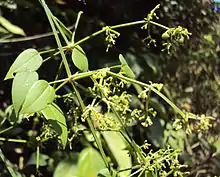| Rubia cordifolia | |
|---|---|
 | |
| Scientific classification | |
| Kingdom: | Plantae |
| Clade: | Tracheophytes |
| Clade: | Angiosperms |
| Clade: | Eudicots |
| Clade: | Asterids |
| Order: | Gentianales |
| Family: | Rubiaceae |
| Genus: | Rubia |
| Species: | R. cordifolia |
| Binomial name | |
| Rubia cordifolia | |
Rubia cordifolia, known as Indian madder,[1] is a species of flowering plant in the coffee family, Rubiaceae. It has been cultivated for a red pigment derived from roots.
Description
It can grow to 1.5 m in height. The evergreen leaves are 5–10 cm long and 2–3 cm broad, produced in whorls of 4-7 starlike around the central stem. It climbs with tiny hooks at the leaves and stems. The flowers are small (3–5 mm across), with five pale yellow petals, in dense racemes, and appear from June to August, followed by small (4–6 mm diameter) red to black berries. The roots can be over 1 m long, up to 12 mm thick. It prefers loamy soils with a constant level of moisture. Madders are used as food plants for the larvae of some Lepidoptera species including Hummingbird hawk moth.
Uses
Rubia cordifolia was the source of an economically important red pigment in many regions of Asia, Europe and Africa. It was extensively cultivated from antiquity until the mid-nineteenth century. The plant's roots contain an anthraquinone called purpurin (1,2,4-Trihydroxyanthraquinone) that gives it its red colour when used as a textile dye. It was also used as a colourant, especially for paint, that is referred to as Madder lake. The substance was also derived from other species; Rubia tinctorum, also widely cultivated, and the Asiatic species Rubia argyi (H. Léveillé & Vaniot) H. Hara ex Lauener [synonym = Rubia akane Nakai,[2] based on the Japanese Aka (アカ or あか) = red, and ne (ネ or ね) = root]. The invention of a synthesized duplicate, an anthracene compound called alizarin, greatly reduced demand for the natural derivative.[3]
The roots of Rubia cordifolia are also the source of a medicine used in Ayurveda; this is commonly known in Ayurvedic Sanskrit as Manjistha (or Manjista or Manjishta) and the commercial product in Hindi as Manjith.[4]
It is known as btsod (Tibetan: བཙོད་, Wylie: btsod, THL: tsö) in Traditional Tibetan Medicine where it is used to treat blood disorders; spread heat (Tibetan: འགྲམས་ཚད་, Wylie: 'grams tshad, THL: dram tshe), excess heat in the lungs, kidneys, and intestines; reduce swelling; and is a component of the three reds (Tibetan: དམར་གསུམ་, Wylie: dmar gsum, THL: mar sum), a subcompound included in many Tibetan preparations in order to remove excess heat in the blood.[5]
In Traditional Chinese Medicine it is known as qiàn cǎo gēn (茜草根).
Pharmacologic properties
The following properties were described in various cellular and animal models:
References
- ↑ "Rubia cordifolia". Germplasm Resources Information Network. Agricultural Research Service, United States Department of Agriculture. Retrieved 22 October 2023.
- ↑ Iwatsuki, K., T. Yamazaki, D. E. Boufford and H. Ohba. 1993. Flora of Japan IIIa: 232.
- ↑ "Material Name: madder". material record. Museum of Fine Arts, Boston. November 2007. Archived from the original on 2011-07-27. Retrieved 2009-01-01.
- ↑ S. Pathania; R. Daman; S. Bhandari; B. Singh; Brij Lal (2006). "Comparative Studies of Rubia cordifolia L. and its Commercial Samples". Ethnobotanical Leaflets (11): 179–188. Archived from the original on 2009-01-07.
- ↑ Gyatso, Thinley; Hakim, Chris (2010). Essentials of Tibetan traditional medicine. Berkeley, Calif.: North Atlantic Books. pp. 167. ISBN 978-1-55643-867-7.
- ↑ Joshan Rani S., Nagarauk R., Anuradha P. "Antibacterial properties of extracts of Indian medicinal plants: Syzygium alternifolium, phyllanthus niruri and rubia cordifolia" Biomedical and Pharmacology Journal 2010 3:1 (123-128)
- ↑ Divakar K., Pawar A.T., Chandrasekhar S.B., Dighe S.B., Divakar G."Protective effect of the hydro-alcoholic extract of Rubia cordifolia roots against ethylene glycol induced urolithiasis in rats" Food and Chemical Toxicology 2010 48:4 (1013-1018)
- ↑ Joharapurkar A.A., ZAMBAD, S.P., WANJARI, M.M., UMATHE, S.N. "IN VIVO EVALUATION OF ANTIOXIDANT ACTIVITY OF ALCOHOLIC EXTRACT OF RUBIA CORDIFOLIA LINN. AND ITS INFLUENCE ON ETHANOL-INDUCED IMMUNOSUPPRESSION" "Indian Journal of Pharmacology" 2003; 35: (232-236)
7 Joharapurkar A.A., ZAMBAD, S.P., WANJARI, M.M., UMATHE, S.N. "IN VIVO EVALUATION OF ANTIOXIDANT ACTIVITY OF ALCOHOLIC EXTRACT OF RUBIA CORDIFOLIA LINN. AND ITS INFLUENCE ON ETHANOL-INDUCED IMMUNOSUPPRESSION" "Indian Journal of Pharmacology" 2003; 35: 232-236
External links
- Caldecott, Todd (2006). Ayurveda: The Divine Science of Life. Elsevier/Mosby. ISBN 0-7234-3410-7. Contains a detailed monograph on Rubia cordifolia (Manjishta) as well as a discussion of health benefits and usage in clinical practice. Available online at https://web.archive.org/web/20110616193446/http://www.toddcaldecott.com/index.php/herbs/learning-herbs/306-manjishta